A thing of beauty is a joy for ever:
Its loveliness increases; it will never
Pass into nothingness...
from John Keats' poem "Endymion"
When I was in grammar school I fell in love with the poetry of John Keats, one of the most famous English Romantics. And then one summer while in college when I was very sad, I buried myself in his work. I started doctoral studies intending to become a scholar of the Romantics, but to tell the truth there were too many such scholars, and the urgency of cultural and literacy studies seemed more purposeful to me. Nonetheless, I remained in love. Today I saw the house where Keats died of tuberculosis at age 25 in the year 1821! The
Keats-Shelley House is to the right of the Spanish Steps; it has been privately owned since 1907 and contains a large library on the Romantics and memorabilia mostly belonging to Keats. Here is the side of the house and his two bedroom windows.
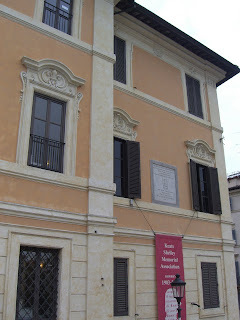
When he looked out these windows, he would have seen the Spanish Steps. Here's a picture I took today, and below it is a picture from a postcard.


Keats was too sick to get out of bed. Occasionally, Severn helped him walk to the adjoining room, where Severn slept. But if Keats could have walked around, and if he could have climbed the Spanish Steps to the entrance of the basilica, this, below, is something like what he would have seen.

At the time of Keats' death, the Vatican law required that when a person died of tuberculosis all of his belongings had to be burned, so, only the rented piano that Keats used was spared. This bed is probably like the one he used to have, the one he died on. This particular bed dates from around 1820 and is made of Italian walnut. It's called a barca a letto (a boat bed); the upholstery is typical of the period.
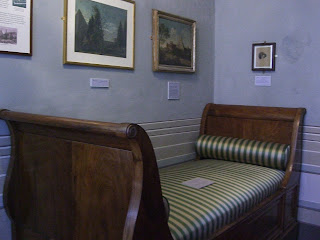
From early on Keats knew exactly what he wanted to do with his life; he wanted to be a poet. In 1816 he wrote in "Sleep and Poetry":
"O for ten years, that I may overwhelm
Myself in poesy; so I may do the deed
That my own soul has to itself decreed."
This oil on canvas portrait of John Keats, below, is a copy of one painted in 1822 by his friend, Joseph Severn. Severn wrote: "After the death of Keats the impression was so painful on my mind that I made an effort to call up the most pleasant remembrance in this picture." In some other place Severn also wrote: "This was the time he [Keats] first fell ill & had written the Ode to the Nightingale (1819). On the morning of my visit to Hampstead I found him sitting with the two chairs as I have painted him & was struck with the first real symptoms of sadness in Keats so finely expressed in that Poem." After Keats' death, Severn painted a number of idealized portraits.

This oil on canvas portrait of Keats, below, was made by Richard Westfall in 1813. Keats wrote about it: "I happen to know this portrait was not a flatterer, but dark and stern... even as black as the mood in which my mind was scorching last July when I sat for it. All the others of me--like most portraits whatsoever--are, of course, more agreeable than nature."
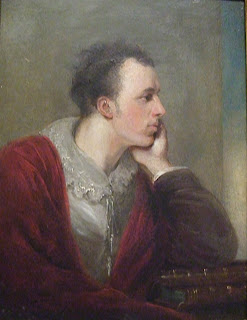
This third portrait, painted around 1819, is by Joseph Severn.

"Beauty is truth, truth beauty, —that is all
Ye know on earth, and all ye need to know."
from "Ode on a Grecian Urn" (and check out the urn he drew).
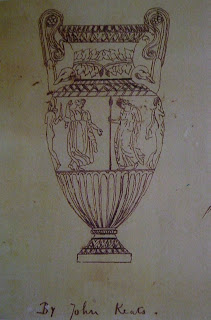
This is John Keats' handwriting, below! It's an excerpt of his poem "Lamia" composed in 1819. He took the subject from a story he found in one of his favorite books, Robert Burton's
Anatomy of Melancholy. In the story Hermes gives human form to a serpent, who as a beautiful woman then ensnares the young philosopher, Lycius. After Keats' death, the manuscript of this poem was cut into strips (like you see in this picture) and given to his friends.
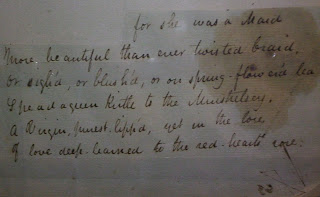
This too, below, is his handwriting; it's a letter to his sister, Fanny. He wrote it a week before leaving England. He wrote: "At any rate it will be a relief to quit this cold, wet, uncertain climate."
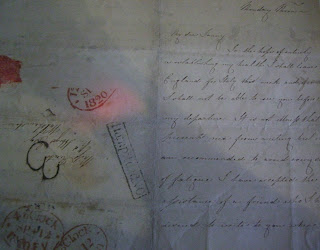
Keats had two younger brothers and a sister, but she's rarely mentioned. Since she was much younger, they didn't spend too much time together, but while he was sick and dying in Rome, she wrote to him every single day. This oil on canvas portrait of Fanny Llanos (Keats) by Juan Llanos (yes, a Spaniard, her husband), depicts her in old age.

After John died, in 1826 when Fanny was twenty-three, she married Valentin Maria Llanos, who had met John in Rome just three days before his death. Fanny and Valentin settled in Spain in 1833. In the spring of 1861 Fanny visited Rome and saw the house on Piazza di Spagna where, forty years earlier, her brother died. She met Joseph Severn who wrote: "For a long time we remained without being able to speak... 'twas like a brother and sister who had parted in early life meeting after forty years. How singular that we should meet in the very place where Keats died."
Fanny went to Keats' grave and planted two bay trees. Keats' youngest brother, Tom, died of tuberculosis at age 19; Keats nursed him through his last days, and that's not long after both their parents died. His other brother emigrated to the United States where he too died, at age 42, of tuberculosis. I guess that sort of relentless tragedy is partly what appealed to me about Keats--and the fact that he kept on going! No matter the loss, he kept on writing and living. He was lucky too; until visiting this house in Rome I didn't know the details of how his friend, Joseph Severn, took care of him while he died, and then took care of his business afterward. That's a good friend.
Keats' death mask, made by Severn.
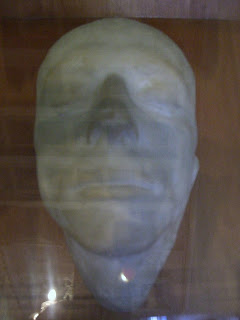
I didn't get to see his grave in the Protestant cemetery, but here's a picture that's on display in the House. He wanted the grave marker to say only "Here lies One Whose Name was writ in Water," but unfortunately his wishes were not respected and other text was added. Severn is buried to the right of Keats' grave.

**********************************************************************************
President George W. Bush in Roma for 2 days!
Wednesday and Thursday
And because of him, I had to walk an extra hour to get to the Galleria Nazionale d'Arte Moderna (pictured below). He and Prime Minister Silvio Berlusconi were meeting at the Villa Madama, right near the museum. Thousands of police officers were out en masse; streets were closed; buses and tram routes deviated; commercial flights banned over the city; protestors watched carefully. People out on the streets were very angry, because they think Berlusconi colluded with Bush and sent troops to Iraq against their wishes. Although almost all those troops are back in Italy, there are about 2,000 still in Afghanistan. They're also pissed because both leaders are now discussing how to force Iran to abandon what they think is an effort to make nuclear weapons. (Italy is one of Iran's top foreign investors.) There were anti-war activists and demonstrators marching in opposition to President Bush's visit and PM Berlusconi's warm welcome. Needless to say, the chaos was not fun for me. But I finally made it to the museum, and lucky for me it was open extra late because it was the first night of an exhibit by
Mario Schifano, a multi-media artist.

I should go to sleep. More later.
